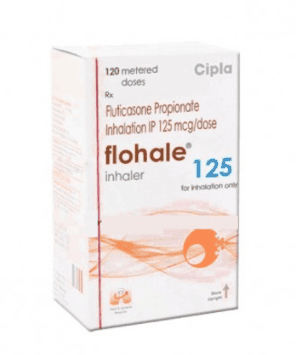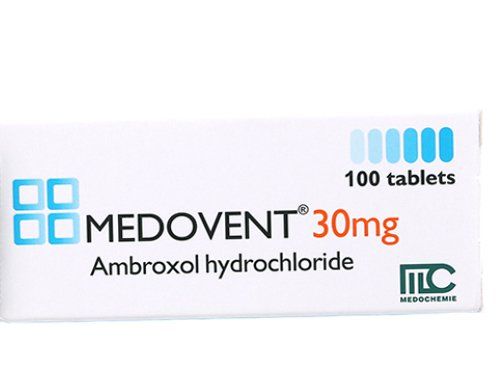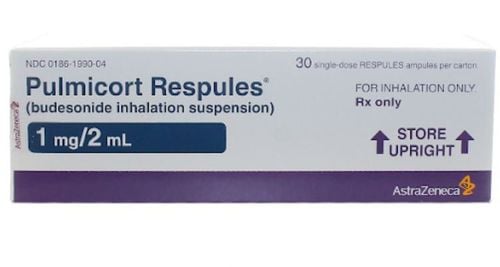This is an automatically translated article.
Formonide 400 Inhaler is made in the form of an aerosol inhaler, consisting of Budesonide and Formoterol Fumarate. The drug is indicated for use in the treatment of asthma (asthma). Let's learn about the drug through the article below.1. What is Formonide 400?
1 vial of Formonide 400 Inhaler contains 48mg of Budesonide and 0.72mg of Formoterol Fumarate (as Formoterol Fumarate Dihydrate). Each dose contains 400mcg Budesonide and 6mcg Formoterol Fumarate (as Formoterol Fumarate Dihydrate).2 Budesonide and Formoterol Fumarate have different modes of action, giving a synergistic effect, reducing asthma exacerbations. The mechanism of action of these two ingredients is as follows:
Budesonide: Budesonide inhaled at recommended doses has the anti-inflammatory effects of glucocorticoids in the lungs, helping to reduce symptoms and asthma exacerbations, with few adverse effects. compared with systemic corticosteroids; Formoterol: Formoterol is a selective beta-2 agonist that causes bronchial smooth muscle relaxation in patients with reversible airway obstruction. The bronchodilator effect is achieved within 1-3 minutes after inhalation, lasting about 12 hours after a single dose; Budesonide and Formoterol: In clinical trials in adults, taking the two together improved asthma symptoms and lung function, reducing asthma exacerbations. Indications for use of Formonide 400 Inhaler:
Long-term treatment of asthma (asthma) in patients 12 years of age and older when a combination of inhaled corticosteroids and long-acting beta-2 agonists is appropriate; Drugs belonging to the class of long-acting beta-agonists may increase the risk of death related to asthma. Therefore, budesonide in combination with inhaled formoterol should only be used in cases where the patient is not well controlled with other asthma medications or when the patient has a marked worsening of asthma on treatment. maintained with 2 therapies; Do not administer to patients with bronchial asthma that is well controlled with inhaled corticosteroids and short-acting inhaled beta-2 agonists. Contraindications to the use of Formonide 400 Inhaler:
Patients for initial treatment of asthma or acute manifestations of asthma when emergency measures are needed; People with hypersensitivity (allergy to) Budesonide, inhaled Formoterol.
2. Usage and dosage of Formonide 400 Inhaler
How to use: Use an aerosol inhaler. Before using for the first time or after not using it for 1 week, patients should try before using the drug. Test by shaking the vial well, spraying 1 puff into the air.Specific instructions are as follows:
Unscrew and remove the protective cap of the vial, check the cleanliness of the vial; Shake the vial well before use; Hold the inhaler upright between your index finger and thumb, exhale gently, place the mouthpiece of the inhaler between your teeth, close your lips; Slightly tilt your head back, breathe slowly through your mouth, press hard to get a dose of medicine while continuing to breathe deeply and evenly; Before exhaling, take the vial out of your mouth, hold your breath for 10 seconds until you feel comfortable, exhale gently; Breathe in through your mouth hard and deeply, do not chew or bite hard on the mouthpiece; If additional doses are required, the steps above should be repeated; Close the cap of the vial; Rinse mouth with clean water, be careful not to swallow. Dosage: 2 inhalations/time x 2 times/day (in the morning and evening), only for inhalation, should be rinsed after each use. If symptoms of bronchial asthma are fully controlled with the above-recommended dosing regimen, a dose reduction to once daily may be considered.
Overdose: When overdosage of Formoterol will lead to typical effects such as tremor, nervousness, headache or tachycardia, hypokalemia, arrhythmia, hyperglycemia, prolonged QTc interval, sadness vomiting and regurgitation. Supportive and symptomatic treatments can be used. With a dose of 90 mcg for 3 hours in patients with acute bronchial obstruction, there is no need to worry about safety.
Acute overdose of Budesonide does not cause clinical problems. With long-term use of excessive doses, patients may experience systemic glucocorticosteroid effects such as hyperadrenocorticism, adrenal medullary suppression.
3. Side effects of Formonide 400 Inhaler
When using Formonide 400 Inhaler, patients may experience some side effects such as:Common: Headache, nervousness, tremor, Candida infection in the oropharynx, cough, hoarseness, mild irritation in the mouth. throat; Uncommon: Tachycardia, muscle cramps, agitation, agitation, restlessness, nausea, dizziness, skin bruising; Rare: Skin rash, urticaria, dermatitis, pruritus, angioedema, bronchospasm, hypokalemia, atrial fibrillation, extrasystoles, supraventricular tachycardia; Very rare: Hyperglycemia, adrenal insufficiency, depression, behavioral disturbances, taste disturbances, fluctuations in blood pressure, angina attacks, etc. Patients should inform their doctor about side effects encountered when using Formonide 400 Inhaler to get advice on the most appropriate treatment intervention.
4. Precautions when using Formonide 400 Inhaler
Before and while using Formonide 400 Inhaler, patients should note:Dosage should be gradually reduced when intending to stop taking Formonide 400 Inhaler, should not stop suddenly; If the patient feels that the treatment is not effective or the dose needs to be increased, it should be done under the supervision of a doctor. Increased use of reliever bronchodilators indicates worsening of the underlying disease, requiring reevaluation of asthma therapy. Sudden and progressive decline in asthma control can be life-threatening and requires immediate medical evaluation. In this case, consideration should be given to the need to increase the dose of corticosteroids or to incorporate systemic anti-inflammatory therapy such as a course of oral corticosteroids or antibiotic therapy if an infection is present; There are currently no data on the daily use of Formonide 400 Inhaler as prescribed by a physician even in the absence of symptoms; Treatment with Formonide 400 Inhaler should not be initiated while the patient is in an asthma exacerbation; The risk of paroxysmal bronchospasm with the drug can occur with wheezing that increases suddenly after the patient inhales the drug. At this point, the drug should be discontinued, treatment reassessed and alternative therapy if necessary; Systemic effects may occur when Formonide 400 Inhaler is used, especially if used in high doses for a long time. Possible effects include: Adrenal suppression, decreased bone mineral density, growth retardation in children and adolescents, cataracts, glaucoma; The height of children being treated with inhaled corticosteroids should be monitored regularly. If growth retardation is present, treatment should be re-evaluated to reduce the dose of inhaled corticosteroids. Also, the benefits and risks for children should be weighed, considering getting additional advice from pediatric respiratory specialists; Limited data from long-term studies suggest that most children and adolescents treated with inhaled corticosteroids eventually reach their target height in adulthood. However, there was an initial mild and temporary decrease in growth (about 1 cm), which usually occurred during the first year of treatment; Long-term studies of inhaled budesonide in children with a mean dose of 400 mcg or adults with a mean dose of 800 mcg did not show any significant effects on bone mineral density; If growth retardation is present and to reduce systemic risk, therapy should be reconsidered, adjusting the dose of inhaled corticosteroid to the lowest dose that maintains effective asthma control; Patients switching from oral steroids to inhaled budesonide remain at risk of adrenal reserve depletion. Patients who have received high-dose emergency corticosteroid therapy in the past or who have used high-dose inhaled corticosteroids for a long time (higher than the recommended dose) are also at risk. Additional use of systemic corticosteroids should be considered during periods of stress or elective surgery; To reduce the risk of oropharyngeal candidiasis, the patient should be rinsed with clean water and then spit out after each inhalation of Formonide 400 Inhaler; Concomitant administration of Formonide 400 Inhaler with ketoconazole or strong CYP3A4 inhibitors should be avoided. If this cannot be avoided, it is necessary to ensure that the intervals between the administration of drugs are as far apart as possible; Formonide 400 Inhaler should be used with caution in patients with thyrotoxicosis, diabetes, pheochromocytoma, untreated hypokalemia, idiopathic subvalvular aortic stenosis, hypertrophic obstructive cardiomyopathy, and hypertension. severe, aneurysm, other serious venous disorders (tachycardia, severe heart failure, ischemic cardiomyopathy); Formonide 400 Inhaler should be used with caution in patients with prolonged QTc interval because Formoterol itself may prolong QTc; The need and dose of inhaled corticosteroids should be re-evaluated in patients with active or latent tuberculosis, fungal and viral infections of the respiratory tract; A risk of severe hypokalemia may occur with high doses of beta-2 agonists. Concomitant use of beta-2 agonists with drugs that cause hypokalemia such as steroids, xanthine derivatives, diuretics,... may increase the hypokalemic effect. Particular caution should be exercised in patients with unstable asthma who are taking different reliever bronchodilators, in patients with severe acute asthma, etc. Serum potassium levels should be monitored while the patient is experiencing other conditions. above status; There are no clinical data on the combined use of Formoterol and Budesonide in pregnant women. Therefore, during pregnancy should be used only when the effect outweighs the risk, the lowest effective dose of Budesonide should be used to maintain good asthma control; It is not known whether budesonide or formoterol passes into breast milk, so this medicine should only be used in nursing women after carefully weighing the benefits and risks and with the consent of the doctor.
5. Formonide 400 Inhaler drug interactions
Some drug interactions of Formonide 400 Inhaler include:Using Ketoconazole 200mg/time/day increases the concentration of oral budesonide (3mg single dose) about 6 times when used concurrently. There is no information on this interaction for inhaled budesonide, but experts believe an increased plasma concentration of the drug is expected. Due to the lack of dosing information, the combination of these drugs should be avoided. If avoidance is not possible, the interval between doses should be extended as long as possible. In addition, consideration should be given to reducing the dose of Budesonide. Other potent CYP3A4 inhibitors may also increase budesonide plasma concentrations; Beta-blockers may reduce or inhibit the effects of the Formoterol component. Therefore, Formonide 400 Inhaler should not be co-administered with beta-blockers (including eye drops) unless authorized by a physician; Concomitant use of Formonide 400 Inhaler with disopyramide, quinidine, procainamide, antihistamines (terfenadine), phenothiazines, MAOIs and tricyclic antidepressants may prolong the QTc interval, increasing the risk of ventricular arrhythmias; L-Dopa, oxytocin, L-thyroxine and alcohol may affect the tolerance of the heart to beta-2 sympathomimetic agents; Concomitant administration of Formonide 400 Inhaler with MAOIs (including agents with similar properties as procarbazine, furazolidone) may promote an hypertensive reaction; Formonide 400 Inhaler increases the risk of arrhythmias in patients who are insensitive to halogenated hydrocarbons; Concomitant use of Formonide 400 Inhaler with other beta sympathomimetic agents may cause a strong additive effect; The risk of hypokalemia may increase the predisposition to arrhythmias in patients receiving cardiac glycoside therapy. In the process of using Formonide 400 Inhaler, patients should strictly follow the doctor's instructions on how to use, dose, ... to ensure the best asthma treatment effect and limit the risk of occurrence. dangerous side effects.
Please dial HOTLINE for more information or register for an appointment HERE. Download MyVinmec app to make appointments faster and to manage your bookings easily.













